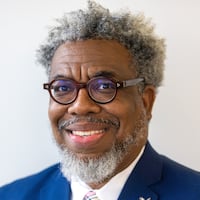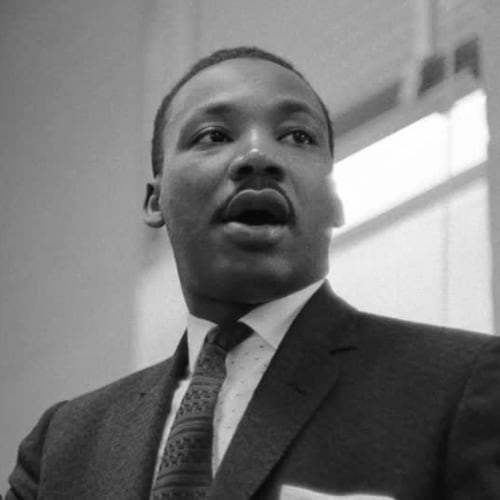Editor’s Note: This story is one in a series of Black History Month stories that explores the role of resistance to oppression in the Black community.
The card room of the Quality Living Services Senior Center in Southwest Atlanta is usually quiet.
At least it is supposed to be during the regular bridge games hosted by members of the local chapters of the American Bridge Association, the oldest and largest Black bridge association in the world.
A whole hand can go without a word being said other than a partner calling what suit to play.
That is why Prudence Brady, playing with her veteran partner Nan Lindsey, was annoyed during a match against Delores Turner and Elaine McCray last month.
Too much chatting and laughing.
“When I first started to play, you can walk in this room and not hear a word,” said Brady, 76. “You not supposed to talk. It distracts you. It throws you off.”
Turner and McCray laughed at the half-serious rant. So did Lindsey, before they all got quiet and resumed play.
In the years before COVID-19 changed the country, the senior center’s card room would be packed daily with bridge players and members of Atlanta’s old-school Black elite of retired doctors, lawyers and educators, gathered for gentle, yet intense, competition and fellowship.
The pandemic’s wake has cut the activity to twice a week — Tuesdays and Fridays at 11 a.m. But the need and desire to be there are still strong, especially for an aging population seeking to remain active, social and, most importantly, maintain their health and mental acuity.
Credit: Natrice Miller / Natrice.Miller@ajc.com
Credit: Natrice Miller / Natrice.Miller@ajc.com
But it is also a place of refuge and a reminder of a time when Blacks and whites couldn’t play cards together. So they created their own communities and built their own organizations, including the American Bridge Association (ABA), devoted to the ancient and courtly game usually associated with white country club housewives.
“We were skeptical because we thought this was a ritzy game for rich, white ladies,” said Andrew Echols, who has been playing since 1964.
It is easy to forget how restrictive Jim Crow laws were and how they forced Black people to navigate the American system. Not only could Blacks and whites not share water fountains and bathrooms, but many Southern states prohibited the playing of cards across the races.
The roots of the American Bridge Association date back to at least 1916, with the creation of the American Tennis Association (ATA), formed after the United States Tennis Association banned Black players from their tournaments.
Credit: Natrice Miller / Natrice.Miller@ajc.com
Credit: Natrice Miller / Natrice.Miller@ajc.com
At the 1932 ATA championships at Hampton Institute, several of the players, who were also bridge enthusiasts, suggested playing evening games as a form of relaxation.
“They would play tennis in the day and play bridge at night,” said ABA national secretary Gloria Christler.
The following year, the ABA held its first national tournament in Buckroe Beach, Virginia.
It wasn’t until 1967 that the American Contract Bridge League opened its membership to Black players. But the ABA still chugged along in its own orbit, hosting two national championships a year and attracting players from all over the world.
“We would plan our vacations around tournaments,” said 89-year-old Benny Patton, who started playing as a Jackson State University student. “This was our sport, and once you get hooked you just go with the flow until you can’t do it anymore.”
Headquartered in Atlanta, the ABA has more than 2,000 members nationwide and about 240 people in Atlanta spread out over seven clubs. Those numbers are down from the group’s peak of about 5,000 because of the pandemic, attrition and the challenge of getting younger people interested in the game.
That has some of the veteran players concerned that the game might one day fade away.
“People have passed away and it is just hard for some people to get out,” said Willetta Phipps, 76, president of the Metropolitan Atlanta Bridge Unit, which makes up the area’s seven clubs. ”Hopefully, it will get better as it gets warmer, but I don’t think we will ever get back to pre-pandemic numbers.”
No trash-talking allowed
Still, on a chilly Tuesday in January, the bridge room at the Quality Living Services Senior Center was buzzing.
Gloria Simmons, president of the University Bridge Club, the first club in Atlanta, who now mostly works as a game director, set up eight tables and placed three decks, or boards, on each of them.
Credit: Natrice Miller / Natrice.Miller@ajc.com
Credit: Natrice Miller / Natrice.Miller@ajc.com
Bridge is played by partners sitting opposite each other — East-West vs. North-South — trying to win a certain number of books in each hand based on a predetermined bid, or contract.
Most of the players are in their 70s, 80s and 90s. Among the youngest is 62-year-old Ron Robinson, who only started playing two years ago. All wear masks.
Most have been playing for decades, having honed their skills at Black colleges, starting with Spades and bid whist, two games that are uniquely Black in their use of language and aggressive playing styles.
Credit: Natrice Miller / Natrice.Miller@ajc.com
Credit: Natrice Miller / Natrice.Miller@ajc.com
“If you went to an HBCU (historically Black college or university), you had to know how to play bid whist to graduate,” said Emma Fountain, former president of the Metropolitan Atlanta Bridge Unit. “I didn’t know Black people played bridge. They all played bid whist and Spades, where you do a lot of bragging and talking.”
Credit: Natrice Miller / Natrice.Miller@ajc.com
Credit: Natrice Miller / Natrice.Miller@ajc.com
So there is no trash-talking or slamming the cards down like in Spades, perhaps the most popular card game among African Americans. But Spades is dangerous. Spades will get you divorced. Spaces will make you flip a table. Spades will get you stabbed.
Bridge, like Brady was trying to get across, is more polite.
“But it is not genteel,” said Christler, who met her husband, Worth, at the bridge table in 1974. “You have to be quiet, but tempers flair sometimes.”
Credit: Natrice Miller / Natrice.Miller@ajc.com
Credit: Natrice Miller / Natrice.Miller@ajc.com
The health factor
Jayne Morgan doesn’t play bridge, but she has been around the game since birth. Her 83-year-old mother Gwen Middlebrooks is an avid player on the local circuit.
The executive director of health and community education at Piedmont Healthcare, where she is the former head of the COVID-19 task force, Morgan said bridge can play a key role in sustaining mental health, especially as people age.
“As we see the population age and life expectancy increase, these issues are going to be important,” Morgan said.
Several of the regular players swear the game helps them stay mentally sharp, and researchers suggest that seniors who spend a significant amount of social time with others engaged in daily activities like card playing may slow down or lower their risks of developing dementia.
“My doctor told me to keep playing because I was starting to forget stuff,” said 81-year-old Janet Waymer, a retired media specialist. “Bridge is good at keeping me active and thinking. After COVID, I just about forgot everything. I am just getting back up to speed.”
Credit: Natrice Miller / Natrice.Miller@ajc.com
Credit: Natrice Miller / Natrice.Miller@ajc.com
According to a 2014 study by the University of Wisconsin-Madison, playing card and board games can help older people retain their mental sharpness, while the frequency of playing games is associated with greater volume in several regions of the brain that are affected by Alzheimer’s disease.
“One thing we do know is, if you are playing and continue to play, it continues to exercise your brain health and helps maintain your cognitive skills, memory, thinking, reasoning and attention span,” said Morgan. “And unlike crossword or jigsaw puzzles, bridge adds that social component as well. That cannot be undervalued as they get older and deal with anxiety, loneliness and isolation.”
The tournament
Last month, in a back ballroom of an airport hotel, more than 100 players from all over the country gathered for the 2023 Martin Luther King Jr. Sectional Bridge Tournament.
Credit: Natrice Miller / Natrice.Miller@ajc.com
Credit: Natrice Miller / Natrice.Miller@ajc.com
At the Friday afternoon Naomi King Scholarship game, which raises money for 24 annual scholarships, 84 players, making up 42 competitive pairs, filled 21 tables to begin what would be a three-hour battle — not for a trophy but for bragging rights.
Naomi King, the wife of Martin Luther King Jr.’s late younger brother A.D. King, wearing a white hat and her signature butterfly pins and rings, sat at a table with her long-time partner Doris Smith.
Patton, an 89-year-old retired probation officer and one of the top players on the circuit with a Grand Life Master title, sat quietly across from his partner Noah Newman before the start of the first match against Waymer and her partner, Willetta Phipps.
Credit: Natrice Miller / Natrice.Miller@ajc.com
Credit: Natrice Miller / Natrice.Miller@ajc.com
Dressed in a black Adidas sweatsuit, Christler didn’t play in the tournament with her husband, Worth. Instead, she played with the current national president Harold Bickham.
Daisy Smith, who has been playing bridge for 70 years, flew down from Washington, D.C., with her son, who is also an avid player. Other players had flown in from Ohio, Illinois and Indiana for the weekend of tournament games.
The players were divided into two divisions based on total points. Pairs like Patton and Christler were in the top division, where each pair played 24 boards, or against 12 other players who rotated through the tables.
Credit: Natrice Miller / Natrice.Miller@ajc.com
Credit: Natrice Miller / Natrice.Miller@ajc.com
Before starting, one of the organizers stood in the middle of the room, clapped her hands and urged the players to “please treat any new players with kindness. Just as you were treated.”
Trash-talking was at a minimum. The worst to come out of the tournament was when Delores Turner, author of the book “We Met at the Bridge Table,” teased opponent Newman when he came to the table wearing a Dallas Cowboys mask.
Occasionally, someone called out, “director,” a signal for Simmons and Andrew Echols, the tournament director, to come over and settle a dispute or interpret a rule.
Credit: Natrice Miller / Natrice.Miller@ajc.com
Credit: Natrice Miller / Natrice.Miller@ajc.com
“Some people say that you never really master bridge, but it depends on the individual. Some people never get it. Some get it on the first lesson or two,” said Echols, who retired from playing to direct tournaments. “But when I played, they knew I was at the tables.”
Because all of the players play the same cards at each table, it is almost impossible to know who wins a tournament until it is over, which heightens the intensity.
At the end of the King game, Linda Dunn from Memphis and Eunice Patton from Bloomington, Indiana, won the top division. Nellie Graham and Howard Prunty, both from Atlanta, won the lower division tournament.
There were no trophies. No cash prizes. No bragging. The winners just earned points and rushed out to pick up dinner. They only had a couple of hours to get ready for the night tournament.
This year, the AJC’s Black History Month series will focus on the role of resistance to forms of oppression in the Black community. In addition to the traditional stories that we do on African American pioneers, these pieces will run in our Living and A sections every day this month. You can also go to ajc.com/black-history-month for more subscriber exclusives on the African American people, places and organizations that have changed the world.
About the Author
The Latest
Featured



